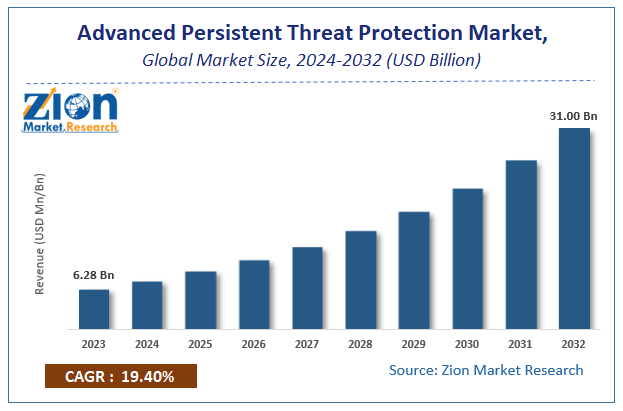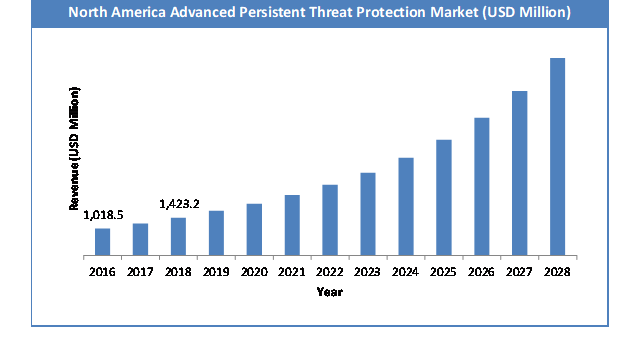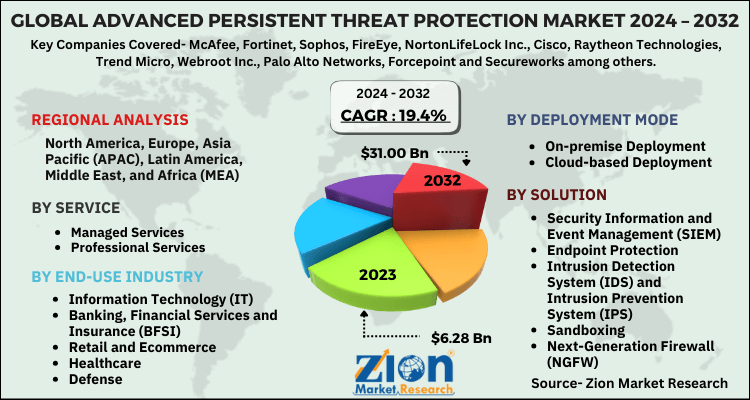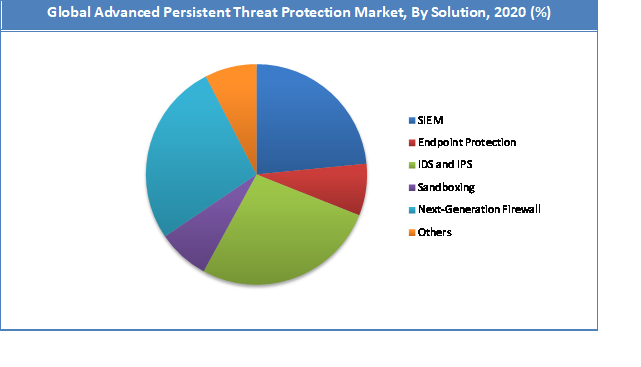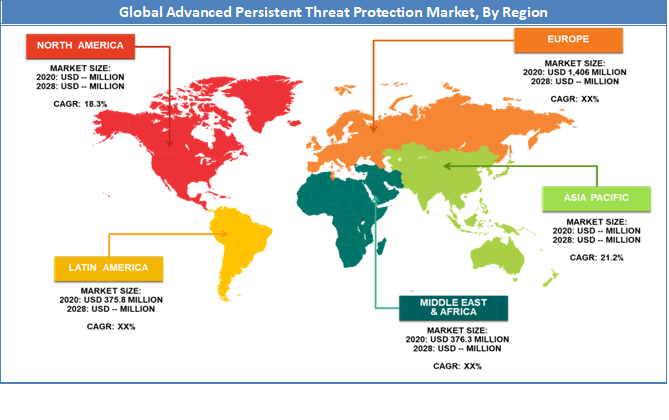Advanced Persistent Threat Protection Market Size, Share, Growth Report 2032

Advanced Persistent Threat Protection Market By Solution (Security Information and Event Management, Endpoint Protection, Intrusion Detection System and Intrusion Prevention System, Sandboxing, Next-Generation Firewall and Others), By Service (Managed services and Professional Services), By Deployment Mode (On-premise Deployment and Cloud-based Deployment), By End-use Industry (Information Technology, Banking, Financial Services and Insurance, Retail and Ecommerce, Healthcare, Defense and Others): Global Industry Perspective, Comprehensive Analysis and Forecast, 2024 - 2032
| Market Size in 2023 | Market Forecast in 2032 | CAGR (in %) | Base Year |
|---|---|---|---|
| USD 6.28 Billion | USD 31.00 Billion | 19.4% | 2023 |
Advanced Persistent Threat Protection Market Insights
According to Zion Market Research, the global Advanced Persistent Threat Protection Market was worth USD 6.28 Billion in 2023. The market is forecast to reach USD 31.00 Billion by 2032, growing at a compound annual growth rate (CAGR) of 19.4% during the forecast period 2024-2032. The report offers a comprehensive analysis of the market, highlighting the factors that will determine growth, potential challenges, and opportunities that could emerge in the Advanced Persistent Threat Protection Market industry over the next decade.
Global Advanced Persistent Threat Protection Market Overview
Advanced Persistent Threats (APTs) are cyber-attacks that are executed by a state or a nation or a group of criminals with the intention to steal data or to surveil the system, for a prolonged duration. The unauthorized user gains access to the host system or network and stays there, undetected, for an extended time span. APT Protection systems offer solutions against these attacks as they are a set of integrated technologies, used for the detection and elimination of threats, from the host system and network.
The increased adoption rate of cloud computing, enhanced demand for system integration and stringent government regulations for cyber security are some of the major factors that are augmenting the growth of the APT Protection market, globally.
Growth Factors
The increased adoption rate of cloud computing, enhanced demand for system integration, stringent government regulations for cyber security and the rising prevalence of cyberthreats and cyberattacks are some of the major factors that drive the growth of the APT Protection market.
Cyberthreats and cyberattacks are widely diverse in nature. Owing to their diversity, they exhibit persistent threat to all form of digital data and activities. Due to the large threat that they present, governments across the world have stringent laws and regulations to protect and maintain the digital safety of their population. This enhances the utilization of APT Protection systems in various sectors, ranging from small scale to large scale business enterprises.
Furthermore, with increased internet penetration, the demand for big data analytics, artificial intelligence, cloud computing and system integration has been on the rise. These features require safe and secure solutions for their smooth and efficient functioning.
Advanced Persistent Threat Protection Market: Report Scope
| Report Attributes | Report Details |
|---|---|
| Report Name | Advanced Persistent Threat Protection Market |
| Market Size in 2023 | USD 6.28 Billion |
| Market Forecast in 2032 | USD 31.00 Billion |
| Growth Rate | CAGR of 19.4% |
| Number of Pages | 170 |
| Key Companies Covered | McAfee, Fortinet, Sophos, FireEye, NortonLifeLock Inc., Cisco, Raytheon Technologies, Trend Micro, Webroot Inc., Palo Alto Networks, Forcepoint and Secureworks among others |
| Segments Covered | By Solution, By Service, By Deployment Mode, By End-use Industry and By Region |
| Regions Covered | North America, Europe, Asia Pacific (APAC), Latin America, Middle East, and Africa (MEA) |
| Base Year | 2023 |
| Historical Year | 2018 to 2022 |
| Forecast Year | 2024 - 2032 |
| Customization Scope | Avail customized purchase options to meet your exact research needs. Request For Customization |
Solution Segment Analysis Preview
The Intrusion Detection System (IDS) and Intrusion Prevention System (IPS) segment held a share of over 30% in 2020. This can be accredited to their features as IDS detects the presence of potential threats, in real time and based on these real time alerts, IPS works on strategies to evaluate and eliminate the risks and threats.
Subsequently, the Sandboxing segment and the Next-Generation Firewall (NGFW) segment contribute to the APT Protection market, majorly. This is attributable to their distinguished ability of providing protection against a multitude of cyberattacks. Sandboxing, upon detection of threats, isolates them, thereby, preventing the host system. NGFW prevents the host system from advanced malware and application layer attacks. It also blocks unnecessary traffic, based on administrator protocols.
Owing to these features, IDS, IPS, Sandboxing and NGFW have found applications in a wide range of sectors such as information technology, ecommerce, retail, telecommunication and manufacturing industries, among others.
Advanced Persistent Threat Protection Market End-use Industry Segment Analysis Preview
In Global Advanced Persistent Threat Protection Market Report, The defense segment is anticipated to grow with a CAGR of over 17% between 2021 and 2028. This is attributable to the fact that intelligence organizations across the globe, operate in aggressive environments. Due to this, they need encrypted solutions for their communication systems, defense strategies and technologies. Additionally, there has been a rise in the frequency of cyberattacks, thus, the Defense segment relies on APT Protection systems for the protection of their data, systems, technologies and communications.
Subsequently, the Healthcare industry is expected to become one of the largest consumers of the APT Protection markets, during the forecast period. This is attributable to the rise of cyberattacks in the Healthcare segment. The healthcare industry registers a number of cyberattacks that include malware execution, data breaches, phishing, among others. These attacks disrupt their services and hinder patient care. These factors increase the adoption of APT Protection systems in the Healthcare segment.
Regional Analysis Preview
The North America region held a share of over 25% in 2020. This immense share can be credited to the presence of prominent players such as McAfee, Fortinet, FireEye, Cisco and Raytheon Technologies, in the region.
Additionally, the North American region has a huge Banking, Financial Services and Insurance (BFSI) sector. It stores tremendous amount of data from credit cards, debit cards, transaction histories and web interactions. It is imminent to protect this data and this makes the BFSI sector one of the largest consumers of the APT Protection market.
Furthermore, the region has a large number of developed economies that invest in Research and Development (R&D) activities, for a wide number of applications. Subsequently, the region has been experiencing increased investments in security solutions for small and large-scale businesses. The boom of R&D and small and large-scale enterprises in the region is expected to enhance the APT Protection market.
The Asia Pacific region is expected to reach a CAGR of over 20% between 2021 and 2028. The region is expected to become one of the largest APT Protection markets globally, during the forecast period. This massive growth can be credited to factors such as the presence of large number of developing economies, stringent government regulations, increased adoption of Machine Learning (ML), Artificial Intelligence (AI), Internet of Things (IoT) and Big Data Analytics, in the region.
Due to the presence of large number of developing economies, the region is investing in businesses such as retail, telecommunications, ecommerce, finance and technology. These sectors are among the top consumers of the APT Protection market. Additionally, government policies dictate protection of customer privacy which enables the enhanced usage of APT Protection systems in these sectors. Furthermore, the region is experiencing increased penetration of internet users. This presents a large number of security concerns that are tackled with the help of APT Protection system.
Key Market Players & Competitive Landscape
Some of the key players in the Advanced Persistent Threat Protection market are:
- McAfee
- Fortinet
- Sophos
- FireEye
- NortonLifeLock Inc.
- Cisco
- Raytheon Technologies
- Trend Micro
- Webroot Inc.
- Palo Alto Networks
- Forcepoint
- Secureworks among others.
The companies in the APT Protection market are focusing on coming up with novel technologies and upgrading their existing technologies. This strategy helps them in catering to the requirements of their end-users proficiently and also helps them in getting an advantage over their competitors. For instance, in July 2020, a new version (Version 7.5) of NextGen SIEM platform was launched by LogRhythm Inc. This new version detects threats and eliminates errors relatively quickly, thereby reduces administration time.
Furthermore, players in the APT Protection market are focusing on partnerships to enhance their products and technologies. For instance, in September 2019, McAfee partnered with Canon to come up with a technology that will provide protection against malware execution on Multi-Function Devices (MFDs).
The global Advanced Persistent Threat Protection Market is segmented as follows:
Global Advanced Persistent Threat Protection Market By Solution
- Security Information and Event Management (SIEM)
- Endpoint Protection
- Intrusion Detection System (IDS) and Intrusion Prevention System (IPS)
- Sandboxing
- Next-Generation Firewall (NGFW)
- Others
By Service
- Managed Services
- Professional Services
By Deployment Mode
- On-premise Deployment
- Cloud-based Deployment
By End-use Industry
- Information Technology (IT)
- Banking, Financial Services and Insurance (BFSI)
- Retail and Ecommerce
- Healthcare
- Defense
- Others
By Region
- North America
- The U.S.
- Canada
- Europe
- France
- The UK
- Spain
- Germany
- Italy
- Rest of Europe
- Asia Pacific
- China
- Japan
- India
- South Korea
- Southeast Asia
- Rest of Asia Pacific
- Latin America
- Brazil
- Mexico
- Rest of Latin America
- Middle East & Africa
- GCC
- South Africa
- Rest of Middle East & Africa
Table Of Content
Methodology
FrequentlyAsked Questions
The global Advanced Persistent Threat Protection market was valued at $ 6.28 Billion in 2023
The global Advanced Persistent Threat Protection market is expected to reach $ 31.00 Billion by 2032, with CAGR of around 19.4% from 2024 to 2032.
Some of the key factors driving the global Advanced Persistent Threat Protection market growth are the increased adoption rate of cloud computing, enhanced demand for system integration, stringent government regulations for cyber security and the rising prevalence of cyberthreats and cyberattacks
North America region held a substantial share of the Advanced Persistent Threat Protection market in 2023. This surge can be credited to the presence of prominent companies like McAfee, Fortinet, FireEye, Cisco and Raytheon Technologies, in the region.
Some of the major companies operating in the Advanced Persistent Threat Protection market are McAfee, Fortinet, Sophos, FireEye, NortonLifeLock Inc., Cisco, Raytheon Technologies, Trend Micro, Webroot Inc., Palo Alto Networks, Forcepoint and Secureworks among others.
RelatedNews
HappyClients
Zion Market Research
Tel: +1 (302) 444-0166
USA/Canada Toll Free No.+1 (855) 465-4651
3rd Floor,
Mrunal Paradise, Opp Maharaja Hotel,
Pimple Gurav, Pune 411061,
Maharashtra, India
Phone No +91 7768 006 007, +91 7768 006 008
US OFFICE NO +1 (302) 444-0166
US/CAN TOLL FREE +1 (855) 465-4651
Email: sales@zionmarketresearch.com
We have secured system to process your transaction.
Our support available to help you 24 hours a day, five days a week.
Monday - Friday: 9AM - 6PM
Saturday - Sunday: Closed

